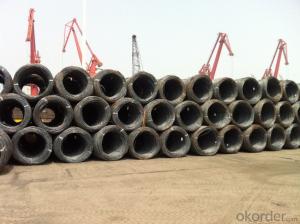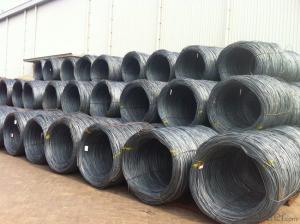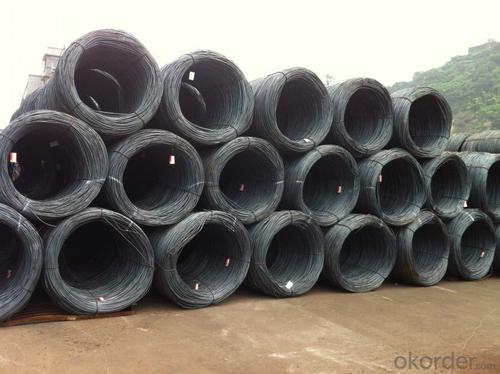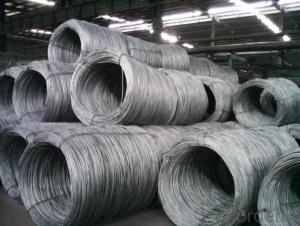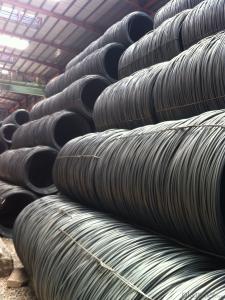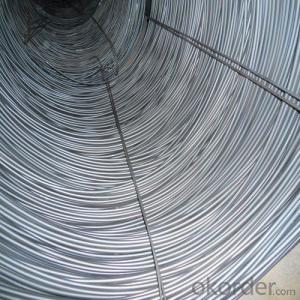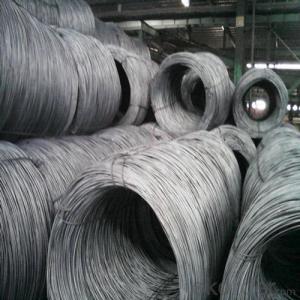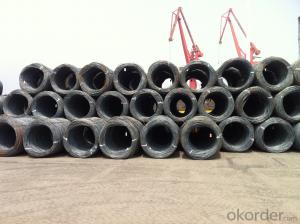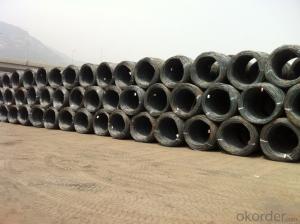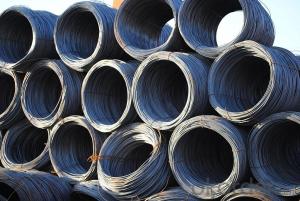Hot Rolled Wire rod SAE 1006-1018 with lowest price
- Loading Port:
- Tianjin
- Payment Terms:
- TT OR LC
- Min Order Qty:
- 25 m.t.
- Supply Capability:
- 10000 m.t./month
OKorder Service Pledge
OKorder Financial Service
You Might Also Like
Product Description:
OKorder is offering high quality products at great prices with worldwide shipping. Our supplier is a world-class manufacturer of steel, with our products utilized the world over. OKorder annually supplies products to European, North American and Asian markets. We provide quotations within 24 hours of receiving an inquiry and guarantee competitive prices.
Product Applications:
After hot-rolled the products shaped into coil and delivery as finished product, including round, square, rectangular, hexagonal and so on, Since most of the products are round, it is generally called wire rod. Steel wire rod is widely used in construction and manufacturing. Steel wire rod is mainly used for reinforcement of reinforced concrete and welded structure or reprocessed (roberts, nail etc) materials, especially used to produce wire drawing, welding electrode, nails,spring, electronic, precise machinery parts and so on.
Product Advantages:
OKorder's wire rods are durable, strong, and resist corrosion.
Main Product Features:
· Premium quality
· Prompt delivery & seaworthy packing (30 days after receiving deposit)
· Corrosion resistance
· Can be recycled and reused
· Mill test certification
· Professional Service
· Competitive pricing
Product Specifications:
Manufacture: Hot rolled
Grade: SAE1006-1018
Certificates: ISO, SGS, BV, CIQ
Packaging: Export packing, nude packing, In Coils
Grade | Chemical Composition (%) | |||||
C | Mn | S | P | Si | B | |
SAE1006B | 0.03~O.07 | 0.32max | 0.045max | 0.040max | 0.30max | 0.0008min |
Mechanical properties | ||||||
Yield strength(N/mm2) | Tensile strength(N/mm2) | Elongation (%) | ||||
250-280 | 350-380 | ≥32 | ||||
Grade | Chemical Composition (%) | |||||
C | Mn | S | P | Si | B | |
SAE1008B | 0.10max | 0.3~0.50 | 0.050max | 0.040 max | 0.15max | 0.0008 min |
Mechanical properties | ||||||
Yield strength(N/mm2) | Tensile strength(N/mm2) | Elongation (%) | ||||
≥195 | 315-430 | ≥30 | ||||
FAQ:
Q1: Why buy Materials & Equipment from OKorder.com?
A1: All products offered byOKorder.com are carefully selected from China's most reliable manufacturing enterprises. Through its ISO certifications, OKorder.com adheres to the highest standards and a commitment to supply chain safety and customer satisfaction.
Q2: How do we guarantee the quality of our products?
A2: We have established an advanced quality management system which conducts strict quality tests at every step, from raw materials to the final product. At the same time, we provide extensive follow-up service assurances as required.
Q3: How soon can we receive the products?
A3: Within three days of placing an order, we will begin production. The specific shipping date is dependent upon international and government factors, but is typically 7 to 10 workdays.
Images:
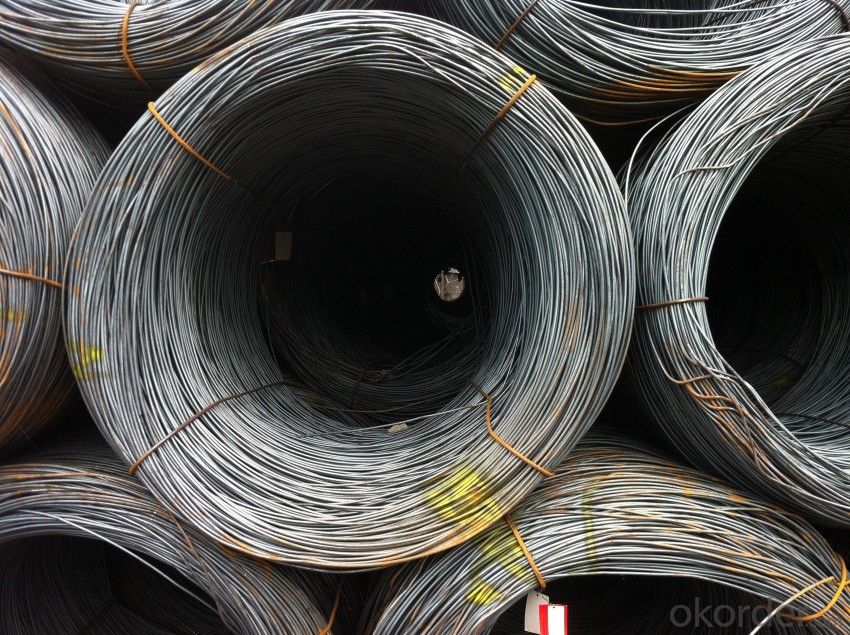

- Q: How is steel wire rod used in the manufacturing of wire for power distribution systems?
- The manufacturing of wire for power distribution systems heavily relies on steel wire rod, a crucial component. This rod, typically made from carbon steel and possessing high tensile strength, is the raw material used to create the actual wire. To begin, the steel wire rod is commonly subjected to a series of processes, including hot rolling, drawing, and annealing, in order to transform it into a thin and flexible wire. During the hot rolling process, the steel wire rod is heated to a specific temperature and then passed through a sequence of rollers to decrease its diameter. This process refines the grain structure of the steel, enhancing both its strength and flexibility. Following this, the wire rod is drawn through a set of dies to further decrease its diameter and increase its length. This drawing process improves the wire's mechanical properties, such as tensile strength and conductivity. A drawing machine is used to pull the wire rod through the dies, resulting in a continuous length of wire. Once the wire is drawn, it undergoes an annealing process. This involves heating it to a specific temperature and then gradually cooling it. Annealing helps to relieve any remaining stresses in the wire, making it more pliable and easier to handle during the manufacturing process. After the wire rod has been transformed into wire, it can be further processed and insulated to meet the specific requirements of power distribution systems. Insulation materials such as PVC or XLPE (cross-linked polyethylene) are applied to the wire, providing electrical insulation and safeguarding against moisture, temperature variations, and physical damage. Ultimately, the insulated wire is utilized to manufacture various components of power distribution systems, including cables, conductors, and overhead lines. These wires play a crucial role in transmitting electricity from power plants to substations, and further distributing it to homes, businesses, and other facilities. In conclusion, steel wire rod is an indispensable material in the manufacturing of wire for power distribution systems. Through processes like hot rolling, drawing, and annealing, the wire rod is transformed into a thin and flexible wire, which is then insulated to meet the specific requirements of power distribution applications. This wire plays a vital role in safely and efficiently carrying electricity over long distances.
- Q: How is steel wire rod used in the production of wire rods for reinforcement?
- Steel wire rod is the primary material used in the production of wire rods for reinforcement. Wire rods are essentially long, cylindrical metal rods that are used to reinforce various structures such as buildings, bridges, and highways. The steel wire rod is first processed through a series of steps to ensure its quality and suitability for reinforcement purposes. These steps include heating the steel rod to a specific temperature, then rapidly cooling it to improve its strength and flexibility. This process is known as quenching and tempering. Once the steel wire rod has been properly processed, it is then fed into a wire drawing machine. This machine pulls the rod through a series of dies, gradually reducing its diameter and increasing its length. This results in a wire rod that is thinner and longer than the original steel rod. The wire rod is then further processed to achieve the desired properties for reinforcement purposes. It may be subjected to additional heat treatments to improve its strength and ductility. It can also be coated with various materials such as zinc or epoxy to enhance its corrosion resistance. After these processing steps, the wire rod is now ready to be used as reinforcement in various construction applications. It is typically cut into shorter lengths and shaped according to the specific requirements of the structure being reinforced. These wire rods are then embedded into concrete or other materials, providing additional strength and stability to the structure. In summary, steel wire rod is a crucial material in the production of wire rods for reinforcement. It undergoes a series of processing steps to enhance its properties, and it is then shaped and embedded into structures to provide strength and durability.
- Q: What are the different types of steel wire rod surface defect visualization techniques?
- There are several different types of steel wire rod surface defect visualization techniques, including visual inspection, magnetic particle inspection, ultrasonic inspection, and eddy current inspection.
- Q: What are the different storage methods for steel wire rod?
- There are several different storage methods for steel wire rod, including coil storage, bundle storage, and pallet storage. Coil storage involves stacking the wire rod coils on top of one another, either vertically or horizontally. Bundle storage involves tying multiple wire rod bars together in a bundle and storing them on racks or shelves. Pallet storage involves placing the wire rod coils or bundles on pallets and storing them in a warehouse or storage facility. Each method has its own advantages and is chosen based on factors such as space availability, ease of access, and transportation requirements.
- Q: What are the typical dimensions of steel wire rod?
- The typical dimensions of steel wire rod vary depending on the specific application and industry. However, common dimensions range from 5.5mm to 16mm in diameter.
- Q: What are the advantages of using steel wire rod in oil and gas applications?
- There are several advantages of using steel wire rod in oil and gas applications. Firstly, steel wire rod offers excellent strength and durability, making it suitable for withstanding high-pressure and harsh environments. Secondly, steel wire rod has good resistance to corrosion, which is crucial in oil and gas applications where exposure to corrosive substances is common. Additionally, steel wire rod can be easily formed into various shapes and sizes, allowing for customized solutions to meet specific project requirements. Lastly, steel wire rod is readily available and cost-effective, making it a practical choice for oil and gas applications.
- Q: What are the weight and length specifications for steel wire rods?
- The weight and length specifications for steel wire rods vary depending on the specific requirements and standards set by manufacturers and industries. However, typical weight ranges for steel wire rods can be anywhere from a few kilograms to several metric tons. Similarly, the length of steel wire rods can vary, but they are commonly available in lengths ranging from a few meters to several kilometers.
- Q: Can steel wire rod be recycled?
- Certainly, the recycling of steel wire rod is possible. Steel, being a material highly amenable to recycling, can undergo a rather uncomplicated recycling procedure when it comes to steel wire rod. Generally, the recycling process entails the gathering of discarded steel wire rod, its subsequent separation from any impurities, and finally, its melting to be reshaped into fresh steel goods. Recycling steel wire rod aids in the preservation of natural resources, diminishes the necessity for mining and producing novel steel, and additionally, yields environmental advantages by curbing greenhouse gas emissions and lowering energy consumption linked to the manufacture of new steel.
- Q: How is steel wire rod used in the production of wire strands for offshore oil and gas structures?
- Wire strands used for offshore oil and gas structures depend on steel wire rods, which are a vital component. These wire strands consist of multiple steel wires twisted together to create a durable and robust cable. The production process starts with inspecting the steel wire rods for quality and removing any defects. Then, the rods undergo a series of heat treatments to enhance their strength and flexibility. This involves heating the rods to high temperatures and rapidly cooling them through quenching. Quenching improves the mechanical properties of the steel wire rods, making them suitable for the challenging conditions found in offshore environments. After heat treatment, the steel wire rods are drawn through dies to reduce their diameter to the desired size. This wire drawing process ensures that the resulting wire strands have the necessary tensile strength and dimensional accuracy. Once the desired diameter is achieved, the steel wire rods are further processed to form wire strands. Specialized machines twist multiple steel wires together to create a strand with a specific number of wires and lay angle. The lay angle determines the flexibility and strength of the wire strand, which is crucial for offshore applications where high loads and harsh conditions must be endured. The resulting wire strands receive various surface treatments, such as galvanization or coating, to protect against corrosion and ensure longevity in offshore environments. These treatments provide additional protection, allowing the wire strands to withstand exposure to seawater, chemicals, and other corrosive elements commonly encountered in offshore oil and gas structures. Finally, the wire strands are cut to the required lengths and assembled into larger cable structures, such as wire ropes or umbilicals. These cable structures play a vital role in supporting and securing infrastructure within offshore oil and gas structures, ensuring stability and integrity even in extreme conditions. In conclusion, steel wire rod is a crucial element in producing wire strands for offshore oil and gas structures. Through a series of processes, including heat treatment, wire drawing, and twisting, steel wire rods are transformed into strong and durable wire strands capable of withstanding harsh offshore conditions. These wire strands are integral components in constructing and maintaining offshore oil and gas structures by providing stability, support, and protection against corrosion.
- Q: How is steel wire rod used in the manufacturing of wire forms for industrial filters?
- Steel wire rod is an essential component in the manufacturing of wire forms for industrial filters. It is used as the raw material for creating the intricate shapes and structures required for effective filtration. The steel wire rod is meticulously processed and shaped into various forms, such as coils, springs, or mesh, which are then integrated into the filter system. Its strength, durability, and flexibility make it suitable for withstanding harsh conditions and ensuring long-lasting performance in industrial filtration applications.
Send your message to us
Hot Rolled Wire rod SAE 1006-1018 with lowest price
- Loading Port:
- Tianjin
- Payment Terms:
- TT OR LC
- Min Order Qty:
- 25 m.t.
- Supply Capability:
- 10000 m.t./month
OKorder Service Pledge
OKorder Financial Service
Similar products
Hot products
Hot Searches
Related keywords

